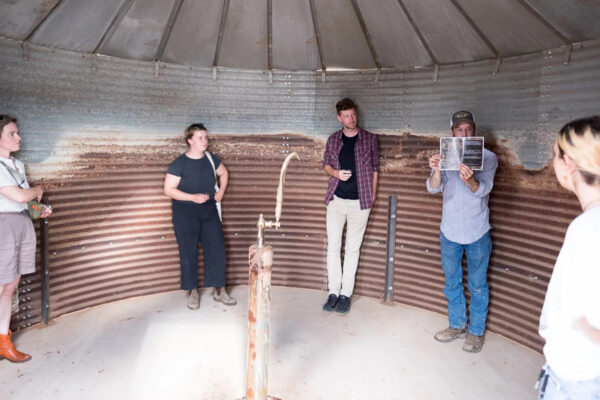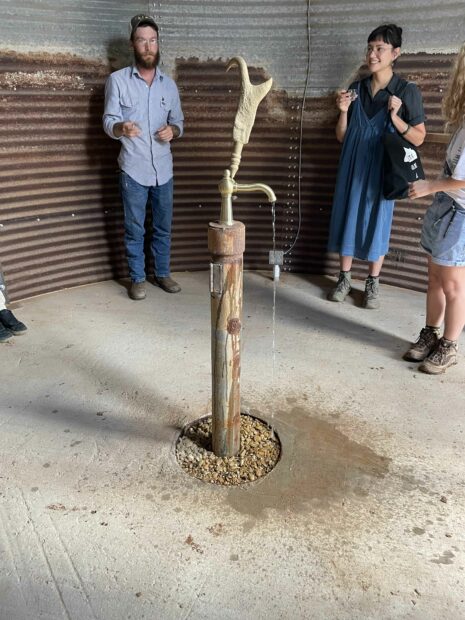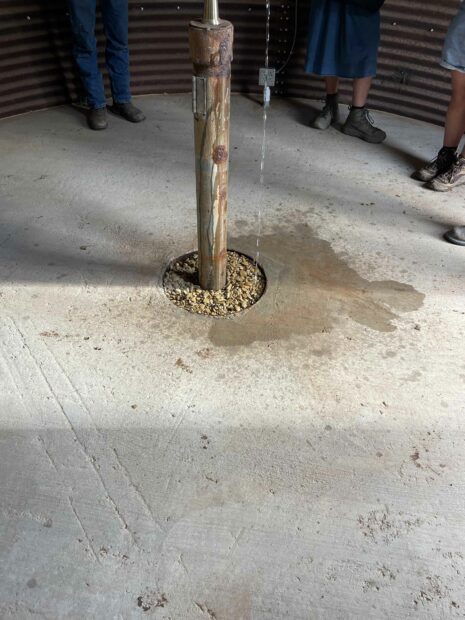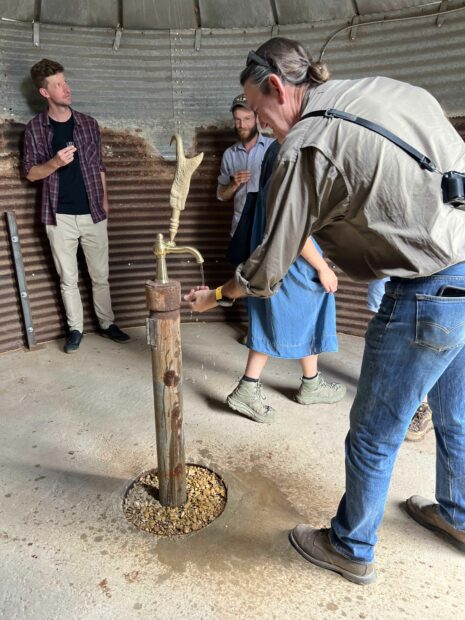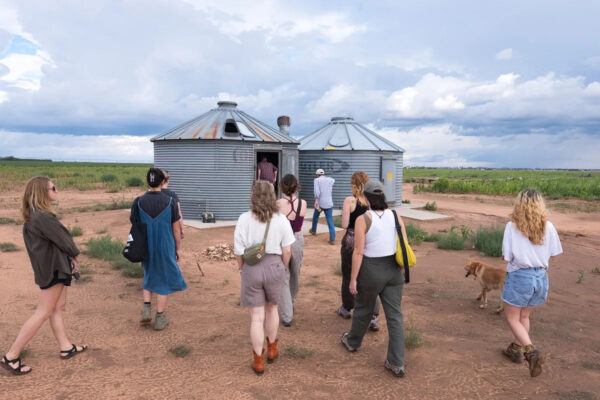
The Land Arts cohort approaching “The Tap” by M12 Studio, led by Eric Simpson and Aaron Hegert, Shallowater, Texas. Image: Chris Taylor.
I visited M12’s The Tap at the end of August 2022, in a group led by Texas Tech University’s Chris Taylor. The next day we would leave to spend the next two months camping together as the 2023 cohort of Texas Tech’s Land Arts of the American West program, but for now we were strangers. On the day we visited, the surrounding farmland was lush from recent rain, the red dirt turned to mud, and the sky was ominous with more rain to come. It never rains in Lubbock, or so we were told.
At first glance, The Tap fits seamlessly into the farm which surrounds it. The work lives in a small silo high on the Llano Estacado, a few miles outside Lubbock in Shallowater, Texas. The metal walls are rusted, the floor is bare concrete. The structure creaks and rattles with the wind or sun or rain. At the center of the silo stands a polished brass water tap, about waist-high, plumbed directly into the underlying Ogallala Aquifer.
Our hosts, Eric Simpson of At’l Do Farms and Aaron Hegert of CO-OPt Research + Projects, turned the tap on and water began splashing on the floor. The brass handle had a mind of its own, slipping in and out of position as Simpson and Hegert laughed nervously, adjusting and readjusting until the water flowed steadily. As The Tap is activated, glasses are carefully removed from a case and visitors are invited to fill a glass and drink, wash their hands, or wet their face. Despite being told to take, touch, and drink freely, an unspoken ritual emerged. We stood in a circle ringing the silo, all eyes on the tap, as we took turns filling glasses, sipping slowly and carefully. One by one we would refill our glasses. The atmosphere was quiet, reverential. I was afraid of being too greedy, afraid to move too fast.
As time passed, we grew more comfortable with this presence. A hand would be rinsed, a bandana wetted, a handful of water cupped and splashed across a sweaty brow. The tap water is filtered only for particulates, leaving it heavy on the tongue with minerals. Our hosts tell us this water would have last been above ground between five and ten million years ago. In this context, the rattling of the silo felt portentous.
Chalybeate waters were prescribed with healing properties across England in the early modern period. In the Grand Pump Room of Bath, Somerset in particular, the medicinal powers of the water were intermingled with a history of religiosity and a mystical understanding of hydrogeology. As Benjamin Allen described in Natural History of the Chalybeat and Purging Waters of England…, published in 1699, “the Chalybeat[e] Waters warm, strengthen, heal, open Obstructions, absterge, invigorate, and thus are capacitated to stop Fluxes of all sorts, and remove many Diseases.” Later in the same text, Allen grasps at straws to explain the warmth of the springwater. These factors converge into a quasi-mysticism, where the inexplicability of the waters is proof in itself of their power.
Lubbock is the city with the eighth-hardest water in Texas, the state with the sixth-hardest water in the country. 64% of that is the mineral-laden groundwater from the Ogallala, which we studied so meditatively. It tasted fossilized, a comestible manifestation of the depth of time beneath our feet.
As we stood circling, Simpson told us the story of At’l Do Farms. He and his family are actively working to create a sustainable and economically feasible model for their farm, which has entailed a transition towards agrotourism. An aerial view of the High Plains shows a grid of circles of green inscribed in squares, the work of pivot irrigation. The aquifer’s rate of recharge lags far behind the current rate of discharge for agricultural use; the water extracted between 2001 and 2008 is almost 32% of the total volume extracted throughout the entire 20th century.
Standing in the stifling silo, listening to the endangered water splashing to the floor as our guides described the crisis facing the Ogallala Aquifer, I could feel panic rising in my body. Echoing through the silo, the white noise becomes deafening, a confrontation with the loss of a resource that is, in practice, non-renewable. We laughed nervously at our tangible discomfort, the guilt and shame of such a frivolous use of something so scarce, so sacred.
In the 19th century, travel guides to Utah commingled the landscape of Utah with religious significance in order to promote rail tourism. The uncharted nature of the Great Salt Lake lent itself to comparisons to the Dead Sea, as in an 1878 promotional brochure published by Union Pacific under the title “To the Rockies and Beyond or a Summer on the Union Pacific Railway.” As Thomas K. Hafen describes, “The Salt Lake Valley became ‘Utah’s Holy Land’ and the supposed curative powers of the hot springs and the Great Salt Lake testified to God’s presence in the land.” By default, the unexplained becomes holy.
Treating water as something sacred makes more sense than anything else in the world. To be confronted with an unexpected body of water feels like a gift, and an inexplicable body of water feels like a god. The idea that eight states — Texas, New Mexico, Colorado, Kansas, Oklahoma, Wyoming, Nebraska, South Dakota — sit atop a prehistoric rock sponge which we are wringing dry in real time, felt preposterous even as we stood there, watching The Tap spill itself onto the silo floor.
Colorado-based artist collective M12 produced The Tap in conjunction with the exhibition The Tap: Visioning the Ogallala Aquifer on the Llano Estacado, presented by Landmark Arts Gallery at the Texas Tech University School of Art in spring 2022. The Tap brings the crisis facing the Ogallala into glaring focus, but it’s not as simple as just turning the water off. Simpson shared the statistic that one section of 640 acres of cotton, the crop historically grown on the Llano Estacado, requires as much water as a single human would use in 9,316 years. This subdues the urge toward self-flagellation, but it doesn’t head off the panic entirely.
As we traipsed back through the fields of At’l Do Farms, fat raindrops began to fall again. Driving home, we splashed through flooding streets. Lubbock lacks storm drains because it never rains. After this excursion, the mineral hardness of water from the kitchen faucet at home, 64% Ogallala groundwater, left a different taste in my mouth.
The unassuming space of The Tap makes the visitor feel powerful in the face of water so enduring. Sustained reverence for water, for its particularity and value, becomes the most natural thing in the world. Continuing that reverence when the tap returns to its natural place in the domestic architecture of our lives, and to question our relationship to it, will require a little more work.
____
- Allen, Benjamin. The Natural History of the Chalybeat and Purging Waters of England with Their Particular Essays and Uses : among Which Are Treated at Large, the Apoplexy & Hypochondriacism : to Which Are Added Some Observations on the Bath Waters in Somersetshire … London: Printed and sold by S. Smith and B. Walford …, 1699.
- Hafen, Thomas K. “City of Saints, City of Sinners: The Development of Salt Lake City as a Tourist Attraction 1869-1900.” The Western Historical Quarterly 28, no. 3 (1997): 352. https://doi.org/10.2307/971025.


